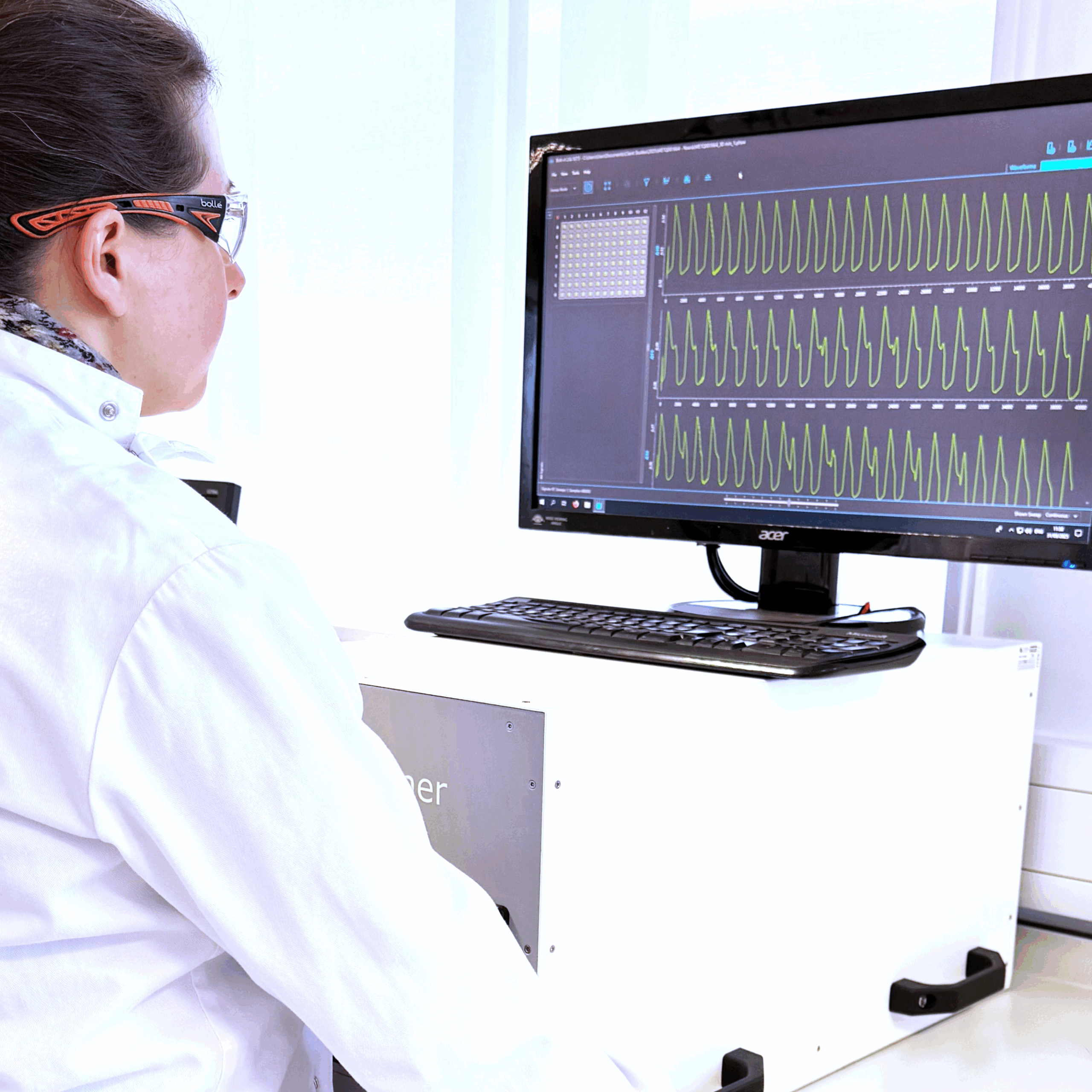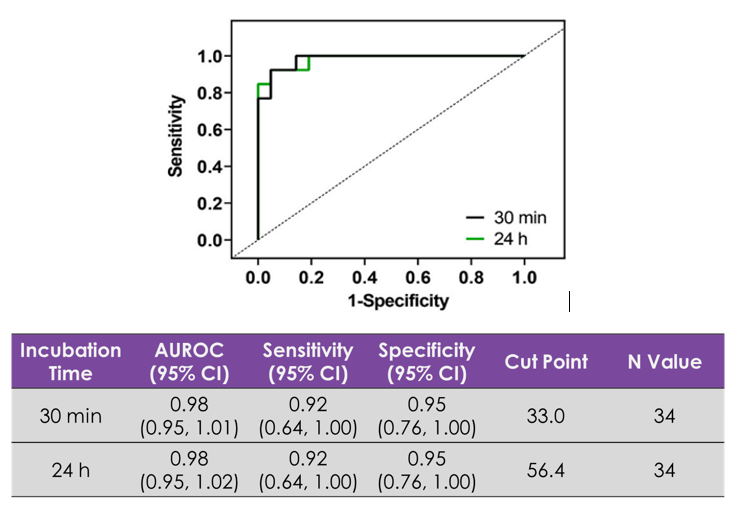Understanding cardiac safety early is critical in drug development. In their latest poster, Jazz Pharmaceuticals, explain how they utilised Metrion’s clinically translatable cardiotoxicity assay to do exactly that.
 Metrion’s human induced pluripotent stem cell (hiPSC)-derived cardiomyocyte assay represents an advanced and cutting-edge tool that provides for early cardiac derisking in drug discovery. This revolutionary model can play a vital role in the evaluation of novel pharmaceutical compounds during the early stages of drug development by enabling researchers to predict potential cardiac risks with higher accuracy and efficiency.
Metrion’s human induced pluripotent stem cell (hiPSC)-derived cardiomyocyte assay represents an advanced and cutting-edge tool that provides for early cardiac derisking in drug discovery. This revolutionary model can play a vital role in the evaluation of novel pharmaceutical compounds during the early stages of drug development by enabling researchers to predict potential cardiac risks with higher accuracy and efficiency.
As the pharmaceutical industry continues to innovate and discover new compounds, ensuring their safety profile is a paramount concern. Drug-induced cardiac events, such as arrhythmias and QTc prolongation, remain among the leading causes of late-stage trial failures. Metrion’s hiPSC-derived cardiomyocyte assay offers early-stage data that can help mitigate these risks, significantly improving drug safety and reducing the reliance on traditional, costly animal studies.
Our clinically translatable cardiomyocyte model offers early decision-making data regarding the potential cardiac risks associated with new compounds. By utilising a hiPSC-derived cardiomyocyte assay, researchers can obtain predictive data on how a compound might affect cardiac function in humans before it enters clinical trials. This data can ultimately prevent late-stage drug development failures and avoid the substantial costs associated with such failures.
In addition to providing valuable information about drug-induced cardiac effects, this advanced model can improve the overall efficiency of the drug discovery process. By detecting potential safety issues early, researchers can make informed decisions about whether to proceed with a compound or pursue other options.
Integrating a clinically translatable assay into your preclinical strategy allows you to protect your development investment, maximise speed to market, and ensure every pound of R&D spend is strategically deployed.
Reduce the risk of costly late-stage failure
Allocate capital towards candidates with the highest probability of success
Accelerate time-to-decision and reach key milestones faster
Protect shareholder value and avoid expensive rework
Strengthen your approach to risk management and due diligence
Fully aligned with regulatory expectations and new approach methodologies
High-throughput, reliable detection of compound-induced effects such as QTc prolongation and arrhythmogenic risk, well before in vivo or clinical studies
Suitable for a range of compound modalities, including those with complex ion channel pharmacology
Seamless integration with cardiac ion channel profiling and toxicity testing
Detect and contextualise risk earlier, including effects missed by acute ion channel studies
Streamline workflow with expert support at every stage
Metrion’s hiPSC-derived cardiomyocyte assay is a higher-throughput, 96-well plate-based system designed to assess changes in action potential morphology, which is a key indicator of cardiac function. The assay can be used to evaluate both acute and chronic exposure to compounds, providing comprehensive safety pharmacology and toxicology data over a range of exposure durations (24 hours or greater). This is especially important for detecting chronic toxicities that may not be apparent during short-term testing.
The 96-well plate format makes the assay highly cost-efficient and suitable for higher-throughput screening.
The assay is aligned with current International Council for Harmonisation (ICH) S7B guidelines for non-clinical cardiac safety testing and adheres to the principles outlined in the FDA Modernization Act 2.0. These guidelines are designed to ensure that drugs are evaluated in ways that are relevant to human health, improving the overall safety and efficacy of new therapeutics. Read about the need to embrace the future of preclinical drug discovery safety.
A critical feature of Metrion’s hiPSC-derived cardiomyocyte assay is its ability to assess the impact of compounds on action potential morphology. Changes in the shape and duration of the cardiac action potential are key indicators of potential toxicity or arrhythmia risk. By examining how compounds affect ion channel activity and their interactions with critical cardiac proteins such as hERG, researchers can gain insight into whether a compound might cause harmful effects on the heart.
Recordings using voltage-sensitive dye (VSD) with quality equivalent to patch-clamp are valuable for assessing cardiovascular risk in drug discovery. They provide a high-fidelity, high-throughput alternative to traditional electrophysiology techniques.
VSD-based recordings offer:

Figure 1. Representative traces from the assay clearly demonstrate how selective ion channel blockers or hERG trafficking block agents influence the action potential morphology of hiPSC-derived cardiomyocytes. This enables detailed analysis of how different compounds might cause changes in the duration and characteristics of the action potential, providing a clearer understanding of their potential risks before clinical testing. Peter Kilfoil, Shuyun Lily Feng, Asser Bassyouni, Tiffany Lee, Derek Leishman, Dingzhou Li, David J. MacEwan, Parveen Sharma, Eric D. Watt, Stephen Jenkinson, Characterization of a high throughput human stem cell cardiomyocyte assay to predict drug-induced changes in clinical electrocardiogram parameters, European Journal of Pharmacology, Volume 912, 2021.
A significant challenge in drug development is the potential for novel compounds to cause QTc prolongation or QRS interval widening, both of which are associated with a higher risk of arrhythmias and sudden cardiac events. Accurate prediction of these issues is essential for identifying and mitigating cardiac risks early in the development process.
Metrion’s hiPSC-derived cardiomyocyte assay:

Figure 2. Metrion’s hiPSC cardiomyocyte assay highlights QRS risk. An ROC analysis of 22 QRS positive and 12 QRS negative compounds clearly defines the ability of the assay to define the free clinical exposure associated with QRS with high accuracy.
Another significant advantage of Metrion’s hiPSC-derived cardiomyocyte assay is its ability to assess compounds over extended periods, up to 48 hours, in serum-free conditions. This allows for the evaluation of chronic toxicities and other long-term effects that might not be detectable in shorter, serum-containing assays. Extended testing durations are critical for assessing the full impact of drugs that may require prolonged exposure to cause adverse effects.
Metrion’s hiPSC-derived cardiomyocyte assay is designed to be reliable, reproducible, and highly translatable to human clinical data. This is particularly important as drug developers are under increasing pressure to ensure that their preclinical studies are predictive of human clinical outcomes. The use of hiPSC-derived cardiomyocytes provides a more accurate representation of human cardiac function compared to traditional animal models, which can often have species-specific differences in ion channel expression and drug response.
Our assays demonstrate the cardiac safety of therapeutic compounds in accordance with current regulatory guidelines, including those set forth within ICH S7B.

Figure 3. Assessing the effect of compounds on the ventricular action potential waveform in a plate-based human stem cell cardiomyocyte model.
The hiPSC-derived cardiomyocyte model offers several key advantages, making it an essential tool for early cardiac derisking in drug discovery:
The assay provides a human-relevant model that better reflects the response of human hearts to therapeutic compounds, which is critical for improving the predictability of drug safety in clinical trials. Traditional animal models, such as those using rats or dogs, do not always replicate human cardiac physiology accurately.
The use of hiPSC-derived cardiomyocytes significantly reduces the need for animal testing, which aligns with the ethical principles of the 3Rs (Replacement, Reduction, Refinement) in animal research. This reduction in animal testing not only improves the ethical standards of drug development but also reduces costs and enhances the sustainability of the drug discovery process.
By identifying cardiotoxic compounds early in the drug development process, Metrion’s VOLTA hiPSC-derived cardiomyocyte assay helps to avoid late-stage failures that can be costly and time-consuming. Early detection of cardiac risks allows for more informed decision-making and resource allocation, ultimately saving time and money in the long run.
This assay can be used in conjunction with other types of cardiac assessments, such as electrophysiological studies, contractility assays, biochemical analyses, and even in vivo studies. Its flexibility makes it an invaluable tool that can complement other experimental systems and provide a comprehensive view of a compound’s cardiac safety profile.
As the FDA embraces non-animal testing methods, Metrion’s Volta assay offers a human-relevant, clinically translatable solution for early cardiac safety assessment in drug development. Using hiPSC-derived cardiomyocytes and high-frequency optical recording, the Volta assay reliably predicts key cardiac risk markers like QTc prolongation, aligning with FDA-endorsed New Approach Methodologies (NAMs) and the CiPA framework. Scalable, reproducible, and validated, it provides an ethical and efficient alternative to animal models, helping sponsors reduce costs, accelerate timelines, and meet evolving regulatory expectations in a post-animal testing era. Read more about embracing the future of preclinical drug discovery safety in a post-animal testing era.
As the FDA embraces non-animal testing methods, Metrion’s Volta assay offers a human-relevant, clinically translatable solution for early cardiac safety assessment in drug development. Using hiPSC-derived cardiomyocytes and high-frequency optical recording, the Volta assay reliably predicts key cardiac risk markers like QTc prolongation, aligning with FDA-endorsed New Approach Methodologies (NAMs) and the CiPA framework. Scalable, reproducible, and validated, it provides an ethical and efficient alternative to animal models, helping sponsors reduce costs, accelerate timelines, and meet evolving regulatory expectations in a post-animal testing era. Read more about embracing the future of preclinical drug discovery safety in a post-animal testing era.
Understanding cardiac safety early is critical in drug development. In their latest poster, Jazz Pharmaceuticals, explain how they utilised Metrion’s clinically translatable cardiotoxicity assay to do exactly that.
Aligos Therapeutics and Metrion explore key approaches to cardiovascular safety screening in drug discovery.